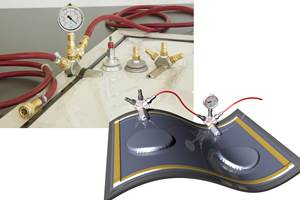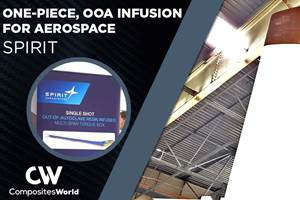Bridging the Centuries with Composites
Bob Sweet, president/CEO of Creative Pultrusions Inc. (Alum Bank, Pa.), established in 1973, is a graduate of the University of the Pacific (BS, business administration) and an active member of the Market Development Aliance (MDA) and the Pultrusion Industry Council (PIC), as well as the American Composite
Share
Read Next
Bridge building is almost as old as mankind. Since someone first rolled a log over a gully, people have been trying to come up with better ways to get across. Some beautiful stone-arched bridges have survived centuries in Europe and elsewhere around the world. As settlers traveled across the U.S., many wooden bridges were built, because wood was plentiful and easy to use. Back then, bridges were made for horse-drawn vehicles, such as surreys and wagons. Eventually, roofs were erected on the bridges to protect the wood from deterioration and, some say, to protect picnickers from summer rains. We have 14 beautiful covered bridges that have survived in our rural county of Bedford, Pa., alone. Refurbished and strengthened to handle car and light truck traffic, they're now historical landmarks that draw thousands of tourists every year.
As the automobile appeared on the scene, however, wooden structures began to disappear. Some were torn down and replaced with stronger metal bridges. This occurred naturally, as well; wooden bridges were usually built close to the water, and were often washed away during floods. New types of truss bridges were designed, using metal as their structural members. However, like wooden structures, metal bridges presented their own problems, which limited their life spans. Metal bridges can be destroyed by rust, and continual maintenance and painting are significant ongoing expenses. Many older metal bridges had to be replaced when roads were widened and heavier traffic exceeded their designed capacities.
In the 1950s, everyone thought that our highway problems were solved as we built large, concrete bridge structures that appeared indestructible. We still have one on the old Lincoln Highway (the first transcontinental highway). It is a beautiful curved bridge, spanning the Juniata River across an enormous gorge. If you look closely, though, you realize that the bridge is no longer structurally sound. A major problem with concrete in cold climates is deterioration due to salts and chemicals used for snow and ice removal. The freeze-thaw cycle opens cracks that allow road salts to penetrate the concrete and attack the metal rebar inside, causing a galvanic reaction. Salt in marine environments is problematic, as well. The engineers' first solution was to epoxy-coat the rebar. But this method required great care and inspection at the construction site, because it soon became apparent that if the epoxy is chipped off the rebar anytime before it is encapsulated in the concrete, galvanic corrosion occurs in the unprotected area, and the bridge is at risk.
As a result, concrete bridges and decks that were built to last forever are generally only lasting 25 years in the Northeastern U.S. and along the coasts. Of the more than 585,000 bridges in the U.S., 181,402 - 31 percent - are currently listed as deficient, needing major repair or replacement.
As steel bridges replaced wooden ones, the cost of the bridges went up, but the performance was increased. The same was true when concrete replaced steel. True to the cycle, composite materials are solving old problems with better, longer-lasting bridges at greater cost - depending on how one looks at cost. We in the composites industry believe that the life expectancy of bridges can be doubled or even tripled, using composite beams and bridge decks. Better performance necessarily costs more because the raw materials used to produce higher performance cost more. But longer lasting, maintenance-free bridges will change the way highway departments spend their dollars. With much less required for the lifetime maintenance costs of composite structures, funds are freed up for investment in the up-front building costs.
Today, composite bridge decks are available in 4-, 5- and 8-inch thicknesses that can be used on federal interstate highways, and tests are under way in approximately 15 states to allow their use on small and large state highway bridges. Not only can the decks carry the heavy loads specified for large interstate highway bridges, they can be installed faster and with lighter equipment, as well. Factory-made to superior quality standards in controlled environments, deck sections are then shipped to the construction site and installed quickly, resulting in less traffic disruption. Gone are the days of trying to cure concrete in the wind and rain.
Some large construction companies have entered the bridge market, both as product suppliers and end users, lending greater credibility to the selection of composite decks. Two years into the 21st Century, the bridge market is just beginning to open up for composite materials. The composites industry and a growing number in the civil engineering community have faith that these new-fangled composite structures will last into the next century.
Related Content
SmartValves offer improvements over traditional vacuum bag ports
Developed to resolve tilting and close-off issues, SmartValves eliminate cutting through vacuum bags while offering reduced process time and maintenance.
Read MorePlant tour: Albany Engineered Composites, Rochester, N.H., U.S.
Efficient, high-quality, well-controlled composites manufacturing at volume is the mantra for this 3D weaving specialist.
Read MoreGKN Aerospace, Joby Aviation sign aerostructures agreement
GKN Aerospace will manufacture thermoplastic composite flight control surfaces for Joby’s all-electric, four-passenger, composites-intensive ride-sharing aircraft.
Read MoreVIDEO: One-Piece, OOA Infusion for Aerospace Composites
Tier-1 aerostructures manufacturer Spirit AeroSystems developed an out-of-autoclave (OOA), one-shot resin infusion process to reduce weight, labor and fasteners for a multi-spar aircraft torque box.
Read MoreRead Next
All-recycled, needle-punched nonwoven CFRP slashes carbon footprint of Formula 2 seat
Dallara and Tenowo collaborate to produce a race-ready Formula 2 seat using recycled carbon fiber, reducing CO2 emissions by 97.5% compared to virgin materials.
Read MorePlant tour: Daher Shap’in TechCenter and composites production plant, Saint-Aignan-de-Grandlieu, France
Co-located R&D and production advance OOA thermosets, thermoplastics, welding, recycling and digital technologies for faster processing and certification of lighter, more sustainable composites.
Read MoreDeveloping bonded composite repair for ships, offshore units
Bureau Veritas and industry partners issue guidelines and pave the way for certification via StrengthBond Offshore project.
Read More











.jpg;maxWidth=300;quality=90)










